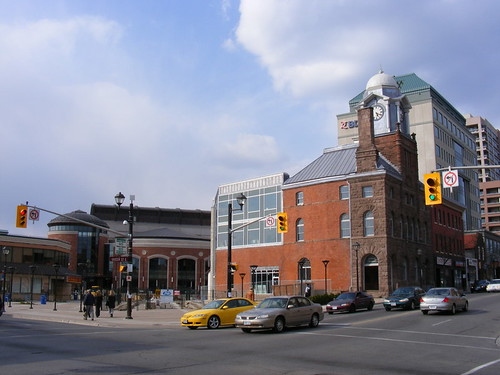
Downtown Brampton, with the 1880s Dominion Building and the Rose Theatre behind.
I grew up in the suburban city of Brampton, just north-west of Toronto. Today, it is one of the most interesting suburban cities in Canada, experiencing rapid population growth and demographic change. I hope to make this one of several tours of my hometown over the summer here at Spacing Toronto. I may have left, wanting something closer to downtown Toronto, but it being so close, I pass through Brampton and can remark on some of the changes over the past few years. A few days ago, I attended a local meeting and took the opportunity to walk around after getting off the GO Train.
Until it was influenced by Toronto’s rapid suburban growth in the 1950s, Brampton was a small town of about 5,000 to 6,000 people, the seat of Peel County and a minor railway junction. Its main industries were mass horticulture (the massive greenhouse complexes gave it its nickname, Flowertown), brick production and a few smaller industries (namely shoe and skate production), a tannery, and a paper cup plant. The shoe and skate plants still stand, but only the paper cup plant is still operational. Today, with a population of nearly 450,000, Brampton could be a mid-sized city in its own right if it weren’t so integrated into the Toronto region.
The first subdivisions were built immediately surrounding the old town in the 1950s and early 1960s, but with the construction of nearby Bramalea (the gigantic post-Don Mills “master planned” community) and piped water access from Lake Ontario with regionalization, the city was consumed by sprawl.
Lost in the suburbanization of Brampton was the historic downtown core. The new city government of 1974 abandoned the downtown by moving to a generic civic centre built for the amalgamated Township of Chinguacousy next to Bramalea City Centre. The courts were relocated to a modernist complex in a field near the new Brampton-Mississauga border. Highway 7 by-passed the downtown, and Highway 10’s through traffic was supplanted by Highway 410.
By 1990, the municipal government saw that its downtown core, one of the only unique aspects of the city, was dying. It moved its city hall back to downtown, in a post-modern building on top of the old bus terminal. The bus terminal was moved beneath a new office building, but with the advantage of being directly across from the GO/VIA station. New lamp posts and other street furniture were installed, and more parking was added. Across the street, Gage Park was improved, with an innovative circular skating path through the park under the mature trees which is very popular in the winter. Still, that was not enough, and the downtown commercial blocks still looked rough.

In 1995, the city tried revitalization again, announcing a new condominium tower and a new retail and movie theatre complex, to be called Market Square. The condo was built, but only the parking garage for the commercial centre was constructed. The city later built a new post-modern performing arts centre (called the Rose Theatre) on the site, that opened in 2006. Unfortunately, that left the old Heritage Theatre, once an Odeon cinema, vacant. A more creative use (an arts and/or Bollywood theatre) is deserving and would bring in more people.
Finally, the downtown core became attractive for new medium and high density residential in the past few years. Several townhouse blocks were built on the area’s periphery, and two more condo towers are now under construction. Another historicist post-modern rental tower was built near the railway station, with some streetfront retail space. The Region is building a low income tower as well, that will also include an underground municipal parking garage.
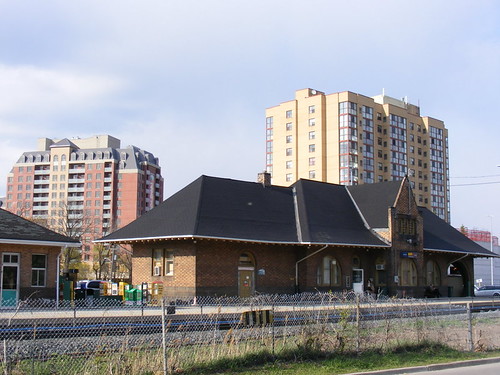
Newer rental towers, perhaps attracted by the nearby rail station.
The Brampton railway station, built in 1907 by the Grand Trunk, sees 6 VIA trains and 9 rush-hour GO trains a day. While the station has the ubiquitous parking lot, it is not that far removed from the rest of the city; the bus terminal (below) is through a tunnel. There will be some limited midday GO train service next year when trackwork is complete, but there is an excellent opportunity to develop a frequent rail service connecting Brampton, the Airport, Weston and Mount Dennis to Union Station and strengthen the communities along the way. The Brampton station parking lot also presents a great opportunity for further urban development. A LRT line between here and Port Credit along Main/Hurontario Streets is planned, and there are major bus-based improvements coming. A strong urban and transport-focused central area might help to keep mostly car-dependant suburbs like Brampton afloat as energy prices continue to increase.
Two of the old factories near the railway station; their presence gives the area a small railway town feel.
Along with the Heritage Complex (the former 1867 courthouse, registry office and jail, one of the only fully intact collection of county buildings left in Ontario) and many other downtown buildings including the Dominion Building, the Carnegie Library and various churches , the area has a wealth of 19th-century and early 20th-century architecture. Perhaps the stagnation of Brampton’s core helped keep these buildings standing.
Surrounding the core are some lovely Victorian and Edwardian houses, in varying degrees of upkeep. Some have been converted to apartments or rooming houses. Others are in pristine condition. I saw a few houses being renovated, perhaps there is some gentrification occurring here.
One of the things that Brampton was lacking was a good coffee shop, though several businesses tried to make a go of it. The latest attempt, part of a small Western Ontario chain, seems to work, with a small patio, and a comfortable interior. It was busier than I expected; and had a decent menu for light meals as well as good coffee and pastries. The late opening hours (it closes at 11:30 each night) helps to bring a small, but important draw to the downtown. Hopefully having more people live here will add needed street-level vitality.
The 1867 Peel County Courthouse.
The 1860s stone jail, closed in 1977 and the site of three hangings, is now a local museum and archives (photo taken June 2007)
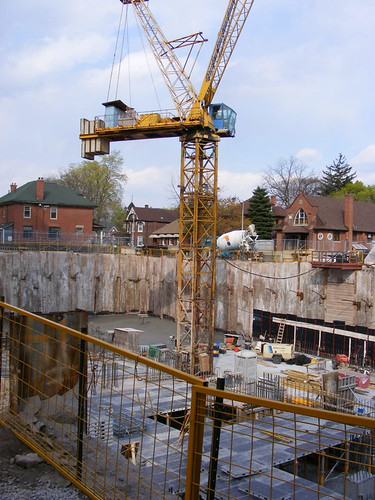
Building the new affordable housing tower.
The new post-modern rental complex near the GO station.
Nearby, the abandoned Peel Memorial Hospital (where I was born) awaits its fate. Residents, angry with the distant and overcrowded new hospital on the other side of town, feel that the city deserves two hospitals and want the old facility re-opened. The hospital board wants the site partially or wholly demolished, with the site being a glorified day clinic.
FInally, I noticed what looks like surveillance cameras around the downtown. Some Canadian cities, such as London and Hamilton, have installed these throughout their downtowns. Interestingly, the notice posted on the light standards say that the cameras are web-cams, and images are not monitored or stored. Yet.
Later installments will focus on my old neighbourhood and on the “master planned”community of Bramalea.

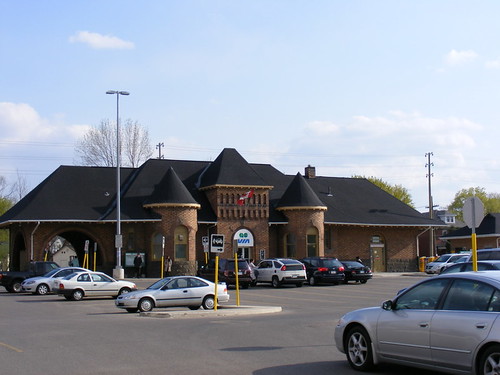
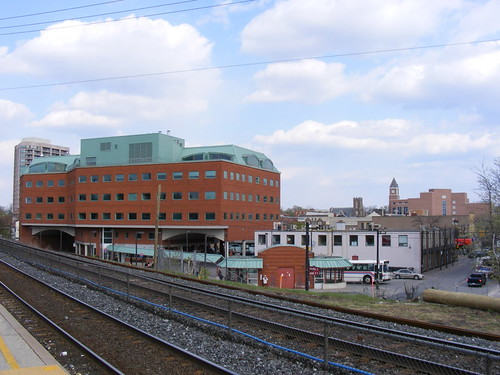


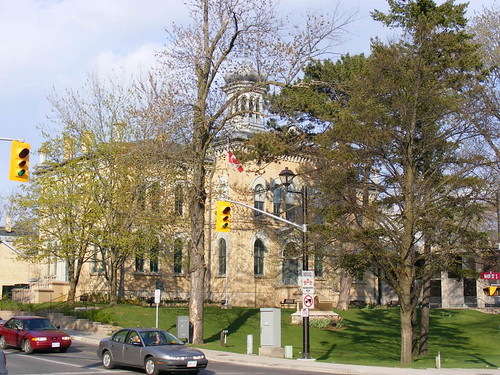
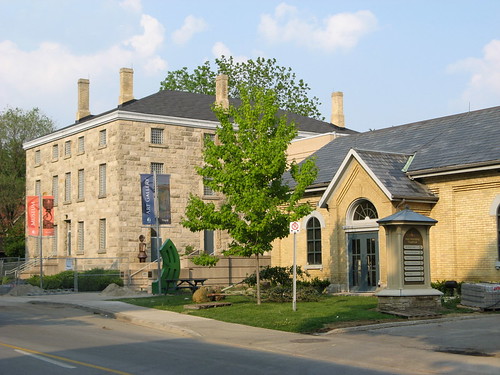

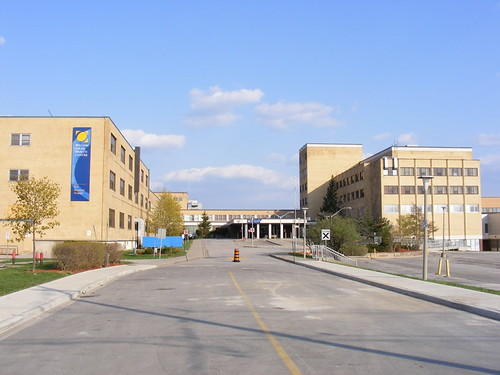

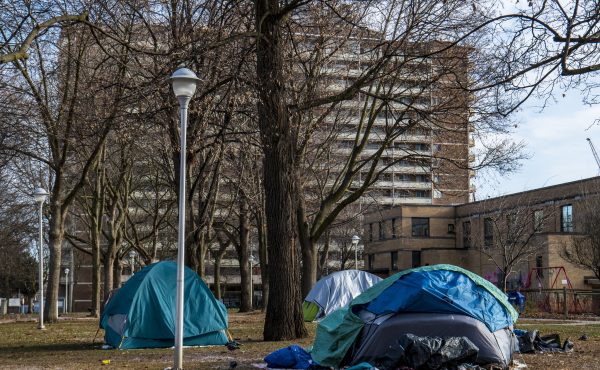
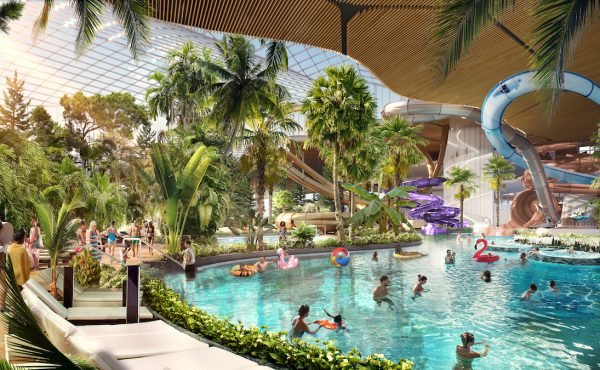

21 comments
It’s not my normal turf, but it’s rough to go out there and the last pic shows just how car-centric it all is – look at the sidewalk.
There aren’t really any grocery stores in the core are there?
Quite a good article. I grew up in Georgetown, something of an annex to Brampton, in the 70s and 80s, and I lived in Brampton from 2003-2005. What you have written about what’s been lost and what’s been saved rings true. That said, it would take a lot for me to ever leave the city (i.e. Toronto) to live there again, for reasons any urbanite doesn’t need me to elaborate.
Brampton is the examplar of what’s been let go wrong in the 905, and parts of the 416. There is more to the story than the usual suburban atrocities: a race and class subtext. My impression in Brampton is that many ‘original’ residents of the town (not native, so god knows what people mean by ‘original’?) are upset that the hospital too eagerly serves the community of ‘newcomers’ (i.e. Punjabi), and that other services do the same. Like most suburbs, areas are ghettoized by income and complexion.
My mother’s property has gained great value on ‘white flight’ from Brampton to Georgetown, as have the developers who doubled Georgetown’s population with “little house made of ticky-tacky”. Her neighbours were told by a real-estate agent that Georgetown was nice because it didn’t have so many of “those people”. Since they’d made many friends working years in Kenya, they told that agent what to do with her comments, though.
I’ve always had a thing for the former railway towns around New York that long ago converted to suburbs. For example, Mahwah, Morristown, and other old NJ towns with their cute train station-oriented main street downtowns in a sea of sprawling residential sprawl. Same could be said for places in Westchester like Tuckahoe or villages like Tarrytown all along the Hudson River. These towns generally have street trees, cafes, lovely landscaping and have generally thrived as places for antiques, art or high-end shopping.
Brampton has experienced much more growth than the above places. It would be interesting to study the bigger, more diverse towns around New York (White Plains, Yonkers, Patterson…) to see if there were some interesting lessons for Brampton. Many of these cities have dealt with similar issues and significant redevelopment has been taking place.
Patterson: http://snurl.com/28i2n
White Plains: http://snurl.com/28i4u
Yonkers: http://snurl.com/28i3y
Thank you for this tour Sean–it’s very good to get a window into a part of the GTA I don’t know well at all, and you provide some excellent context and commentary. I would love to see more stuff like this on Spacing, since as much as it pains me as a die-hard downtowner to admit it, the following seems evident: for a whole range of issues about which we Spacing-reading progressives care (urbanism, transport, ethno-racial relations, etc)., Canada’s future is going to be largely decided not on Bloor Street but in places like Brampton (and Markham and Surrey and Laval and so on). It’s these landscapes and their attendant problems and successes that already define life for a staggering proportion of Canadians, and for that reason they deserve some serious attention.
That said, it shouldn’t be *exclusive* attention, at the expense of ignoring problems (like the parlous state of transit) in the central GTA.
Yah, Hamish. That sidewalk isn’t representative of all of them, but it’s not all that inviting. The nearest large grocery stores aren’t too far away, just over one kilometre in each direction from the downtown at McLaughlin, Kennedy, Vodden or Nanwood, but none right downtown. There was a Loblaws until 1980 though.
This is how I would reimagine a GO Station (besides frequent all day service); making them a mini-hub for day-to-day shopping, perhaps a daycare, and residental. Imagine those car commuters parked in the GO station being able to drop into a grocery store right there and save at least one trip. Or dropping their toddlers off at a daycare. There’s a drycleaning pick-up window inside the Brampton GO station that does well enough.
You’re not going to get everybody on the bus to get to a GO Train (though some people might like to pick up a few groceries and walk or ride the bus the rest of the way home), but you can save unnecessary trips and the businesses can serve a local population as well.
Aidan: The more established areas of Brampton (say anything built before 1985) is still very much comprised of that “original” population. And I knew people that moved to Georgetown or even Orangeville. But housing values remained high and all the services and friends I knew stayed, so apart from cough, racial insecurity, I never got it. Of course, these days, the joke’s on them with more traffic on the roads leading to those outposts and fuel prices increasing. I planned to visit this issue in a later post as my old neighbourhood (built between 1975 and 1985) saw some of this change.
Matt: The 905 municipalities need to find something to build upon, and create urban and transport-oriented corridors, much like what Toronto is trying to do with the Avenues and the ambitious, yet somewhat problematic, Transit City plan.
Downtown Brampton is an organic, historic and unique area to grow out from (unlike the city centre around a shopping mall in Mississauga). The key will be the improved transit links now that residental intensification has taken hold. The city should also try getting more jobs here as well.
Excellent update – I, too, was born at Peel Memorial (my parents lived in Bolton at the time). That courthouse building is lovely, I’m glad it has survived at least.
As ubiquitous GO parking lots go, Brampton strikes me as being one of the better ones, although not as good as, say, Port Credit. Brampton has about 1000 spaces, but the main lot is only about 630. Port Credit also has not quite 1000 spaces but they are spread out amongst a number of smaller lots no bigger than 370 spaces. Compare this to a lot of the stations outside of traditional village centres, where there can be 2000 spaces or more and the main parking lots can be anywhere from 1000 to 1500 spaces.
I still have my fingers crossed that Mississauga will become more pedestrian friendly when the new rapid transit goes in on Hurontario.
Re good-coffee-shopesque places, is that homespun hole-in-the-wall next door to City Hall on Main Street still kicking?
I tried to post a comment comparing Brampton with the larger railroad towns-now-suburbs around New York (like White Plains, Patterson, or Yonkers) but it seems that spacing no longer accepts comments with links. This has happened to me a couple times now. Can that feature please be re-enabled?
Re: Brampton – never seen it before, so thanks for the tour. The lack of street trees and featureless parking lot in front of the train station were rather depressing, but that seems to be a consistent Ontario problem.
uSky> It’s up now (scroll up). It was caught in the spam filter, not a case of disabling links. Perhaps it needs an upgrade though.
If anybody’s comment disappears, post a simple comment that that happened, and we’ll check the filter. As an aside, man is it a nasty place in there. So much of the spam is the most vile and nasty stuff you’ve ever seen.
uSkyscraper: Yes, Brampton is huge. I believe it is the third largest suburban city in North America, after Mississauga and Mesa, Arizona. I wouldn’t be surprised if Brampton passes Mesa in the next few years either.
The downtown therefore is less significant in size than say Yonkers, which is less than half the size of Brampton, and this poses a bigger challenge because it is still unknown to so many residents, especially those living in the northeast part of the city. Brampton has for years been trying to promote an urbanization of the Queen Street corridor, home to a 1950s/1960s era auto row of fast food, auto dealerships and sketchy motor hotels and cheap retail outlets in old 1960-era warehouses. It hasn’t yet caught on, but there’s room for intensification if there’s ever demand.
There’s several parks and nice leafy neighbourhoods around the downtown, and it would have looked greener had I not taken the pictures on April 30, when many trees are still budding. But the lack of trees along the main streets (with somewhat narrow sidewalks) is noticeable.
I’ll be interested to read about how much of the old suburban 1950s-1960s part of Brampton was influenced by Bramalea Limited. It was one of the larger home builders in the GTA until it fell victim to the commercial real estate collapse in the early 1990s and went bust. Its legacy includes Palace Pier and Palace Place, the renovation of the old Confederation Life building on Richmond St. When I did some work there in the early 90s, their main claim to fame was still that “they built Brampton”. One employee was still there in 1995 from Day 1 in 1957.
Rob,
Everything east of Highway 410 and west of Airport Road, between Steeles and Bovaird was built by Bramalea Limited. Bramalea, which is interesting as an attempt at a corportate “New Town”, will be a topic of its own later this summer.
A tidbit: Bramalea is derived from Brampton, Malton, and the word lea, or meadow.
The ‘Brothers Cosmoline’ have a depressing song, titled suitably, “Bramalea”. I was driving on the 410 through the industrial wasteland that splits Brampton from Bramalea when the CBC played it.
I moved back to the city the same year.
Having lived in college towns and cities such as Amherst, MA, and Pittsburgh, part of me feels that what Brampton lacks is an educational hub that would drive cultural growth. I heartily agree that the Heritage Theatre would be put to best use as an arthouse theatre (an excellent model would be the Pittsburgh Filmmakers group in the ‘Burgh). The neglect of cultural life is palpable here; that a city of nearly half a million has only 2 generalist bookstores (the Chapters on 10 and Bovaird, and the tiny Coles in the City Centre) astonishes me.
“One of the things that Brampton was lacking was a good coffee shop, though several businesses tried to make a go of it. The latest attempt, part of a small Western Ontario chain, seems to work, with a small patio, and a comfortable interior”
Wayne was this a mention of your home away from home “Coffee Culture”? To sum up Brampton in a not so fancy way as the others have, the city is boring! No one stays in Brampton to do anything when they want to be entertained, or just have fun. The problem is no one likes going downtown anymore either (violence, traffic, gas, cost, etc), so where does one go to have a good time? A lot of people flock to the Mississauga entertainment district because they have it all. If Brampton wants to ever be considered a “great” city, we have to make more of an effort to have more establishments that will have people saying “we can just stay local” thus pumping cash back into the local economy, as opposed to saying “there’s nothing in Brampton let’s go anywhere else”.
One can reflect on the beauty of Brampton, but like most things associated with sprawl, Brampton’s beauty is quickly fading.
With the bulk of our current development predicated on 30’x 80′ “premium lots”, it is only the older parts of Brampton that retain any semblance of “Beauty”
However, even these older parts are fading with our lack of adequate transportation and emphasis our on new growth. With the apparent attempt to envelop Georgetown to the west and all existing farmland to the north, it is my belief thet the more beautiful parts of Brampton will disappear as did the “Beautiful” village of Meadowvale.
I grew up in southwestern ontario and lived in brampton for 4 years after getting married. I agree with all the comments posted. From experience I can say that Brampton in only a place to sleep and not a place to live. There is no culture in the downtown core and it is a dangerous area. There is a real crime issue that has been growing in the past years and it is no longer a community that I would raise my children in.
In regards to the downtown core I think the city should look to municipalities like Cambridge’s (galt, preston and Hespler) These towns have embraced there downtowns and made them thrive even though the majority of the residents live in subdividions that are not close enough to walk. These downtowns actually draw their citizens out of the subdivisions with authentic farmers markets, antique stores and great restaurants.
Saldly though, I really don’t think there is any hope for Brampton’s downtown core. Brampton’s ethnic boundary lines are tangible and the residents don’t like to mix it up. They stay on their own side of the fence. Creating a downtown core that would appeal to all the residents, many who are so immersed in their cultural community that they don’t even speak english, would be impossible.
I live in Brampton. I must say I do like living here. Sadly, When Brampton is in the news, usually it is about a negative incident.
My husband and I were spending a weekend in Kingston, which is another charming city. We were in a hotel and watching FoodTV network and the show we were watching was the one about someone going through the process of starting a new restaurant (I forget the name of the show). This one episode was about an upscale French restaurant.As we were watching, we figured out it was a restaurant in the Downtown Brampton area called ‘Aggie Martin’! We were so thrilled and happy to see that. We still have a long way to go. But I am glad that our Mayor is doing her best to improve Brampton, especially the downtown core. We now have a fabulous new theatre called Rose Theatre. My favourite hangout is the new upscale coffee shop which is only a few steps away from Rose theatre called ‘Coffee Culture’. There are several charming places in Brampton. I don’t ever regret living here.
I’ve lived in Brampton since 2004.Right now, I live on Main St., a couple of blocks north of Queen St. I Know nothing of Brampton. The only newspaper is a give-away, wrapped around a couple of pounds of real estate advertisements. There is no radio station. There is no t.v. station, except for some amateur Rogers local cable. Every day, there are accidents and fires, but none are ever reported. What happened? was anyone hurt? CanI help in any way? There is no sense of community at all. There is nowhere to stroll to in downtown Brampton.At night, the streets are empty, except for pan handlers, ugly crack whores, shady characters, and bums. A woman I know get accosted on Church street daily on the way to work, mistaken for a prostitute. No respectable citizen goes out on foot. Several blocks of Main and Queen are down to only one lane in each direction, because of permanent parking in the curb lane. The drivers race up the curb lanes and change lanes in the intersections, making crossing the roads very dangerous. I have witnessed two pedestrians hit, have almost been struck myself, and know one who was almost killed. I don’t know where the good or bad neighbourhoods are. I wouldn’t buy a house here. My observation is that Brampton is a collection of groups of strangers that don’t know each other, and don’t want to. Everyone I know from here is just marking time until they retire, and can leave the next day, Including me.